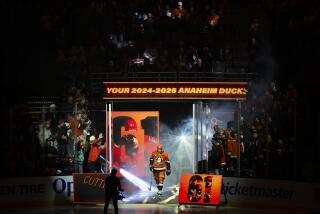These Ducks Way Ahead of the Pac
- Share via
You could argue all day about politics, paper versus plastic, or even what’s up with Ted Danson’s hair, but there is no debate on this:
Oregon is the Pacific 10 Conference’s model football program and has been for years.
Oregon has won more games than any other conference school since 1995, is coming off consecutive league titles, won 11 games last year for the first time in school history, should have played Miami in the Rose Bowl for the national title and has done it all without having to hold a news conference to go over the coach’s transgressions with the NCAA (not to mention any names, Rick Neuheisel).
Oregon has reached that glorious program point where it gets credit just for showing up, which explains how this season’s 5-0 squad, which has yet to defeat a ranked opponent, starts Saturday’s game at UCLA with a top-10 national ranking.
Football powers such as Nebraska and Penn State have enjoyed this status for years.
“If this happened five or six years ago, there’s no way we would be ranked in the top 10,” Duck Coach Mike Bellotti acknowledged this week. “It’s not just a testament to what Oregon has done, it’s a testament to where the Pac-10 is nowadays.”
Oregon’s web print is all over the Pac-10. Four of the league’s 10 coaches are former Oregon offensive coordinators--Bellotti, UCLA’s Bob Toledo, California’s Jeff Tedford and Arizona State’s Dirk Koetter.
Frankly, this uprising out of Eugene borders on mind-boggling, when you consider that Oregon once went 37 years between conference titles.
For years, Oregon was famous for producing scores of assistant coaches who went on to become head coaches who beat Oregon.
The school has yet to earn its national championship in football, yet provided the incubator for several bright young coaching minds. John McKay left the Oregon staff and led USC to four national titles. John Robinson tutored in Eugene, followed McKay to USC and won a piece of his own national crown.
George Seifert, who later coached the San Francisco 49ers to two Super Bowl titles, was an Oregon assistant from 1967-71.
And what about close calls?
Bruce Snyder, Oregon staff 1967-71, led Cal to a 10-victory season and nearly led Arizona State to the national title in 1996, and Toledo, an Oregon assistant in the 1980s, came close to delivering the goods for UCLA in 1998.
What gives?
“It’s the Willamette [River] water,” Toledo joked this week. “John McKay used to drink it with his vodka and so did Robinson, right?”
Toledo described Oregon as “kind of the cradle of coaching on the West Coast. I thought Pacific was for a while when I was there, but it’s actually Oregon.”
Young coaches flocked to Oregon for apprenticeships but never saw it as a final destination.
It was only after the player talent started to rise in the 1980s and ‘90s that Oregon was able to develop coaches and champions.
Rich Brooks, Oregon’s coach from 1977 through 1994, gets credit for steadily upgrading the product in Eugene. After Brooks took Oregon to the Rose Bowl in the 1994 season, he left to coach the Rams. Bellotti then took the Ducks to unprecedented heights.
Still, Toledo thinks the most important cog in Oregon’s turnaround toils in the shoe business.
Toledo remembers going to the 1995 Rose Bowl to watch his friend, Brooks, lead the Ducks against Penn State.
“I thought, ‘They just can’t maintain this thing,’ ” Toledo said. “It’s a credit to them and to the best owner in college football, Phil Knight.”
Ouch.
Knight, of course, is a co-founder of Nike, based in Beaverton, and a huge Oregon donor.
“He’s done a great job with those facilities,” Toledo said. “They get a new toy every day, from what I hear.”
No doubt, the infusion of money has allowed Oregon to construct state-of-the-art facilities and to plaster posters of its players in Manhattan. Top players, who once would never have considered Oregon, if only because of the weather, are now taking the program seriously.
Lousy weather? No problem. In 1998, Oregon cut ribbon on the $15-million Moshofsky Center, an indoor practice facility, and this year the school put the finishing touches on a $90-million expansion of Autzen Stadium.
For years, Oregon has had what amounts to kids working on dissertations coaching the offense, a lineage that included Toledo, Bellotti, Al Borges, Tedford, Koetter and, this year, Andy Ludwig, last year the offensive coordinator at Fresno State.
“They kept the best of all those coordinators in that package,” said Koetter, Oregon’s offensive coordinator in 1996-97. “They have some really good stuff, and now they have some outstanding players to go on top of their good scheme.”
Although Oregon continues as a steppingstone for coaches, the difference now is, the hometown team is also reaping benefits.
When Bellotti lost Tedford this year to Cal, he was inundated with resumes.
“The quality of applicants, when I’ve had positions lately, certainly improved dramatically,” Bellotti said. “For our last offensive coordinator’s job, I had a former Pac-10 head coach and an offensive coordinator.”
Bellotti ended up hiring Ludwig, who last year mentored quarterback David Carr at Fresno State.
It was a pretty good swap.
Bellotti gave up Tedford, who’d coached Joey Harrington, the No. 3 pick in the NFL draft, for Ludwig, who’d coached Carr, the No. 1 overall pick.
If tradition follows, and Ludwig gets his Ducks in a row, he might in two or three years become the fifth former Oregon assistant to get a top job in the Pac-10.
It then might be time to split the league into two divisions: Pac-5 and the Oregon 5.
More to Read
Go beyond the scoreboard
Get the latest on L.A.'s teams in the daily Sports Report newsletter.
You may occasionally receive promotional content from the Los Angeles Times.







